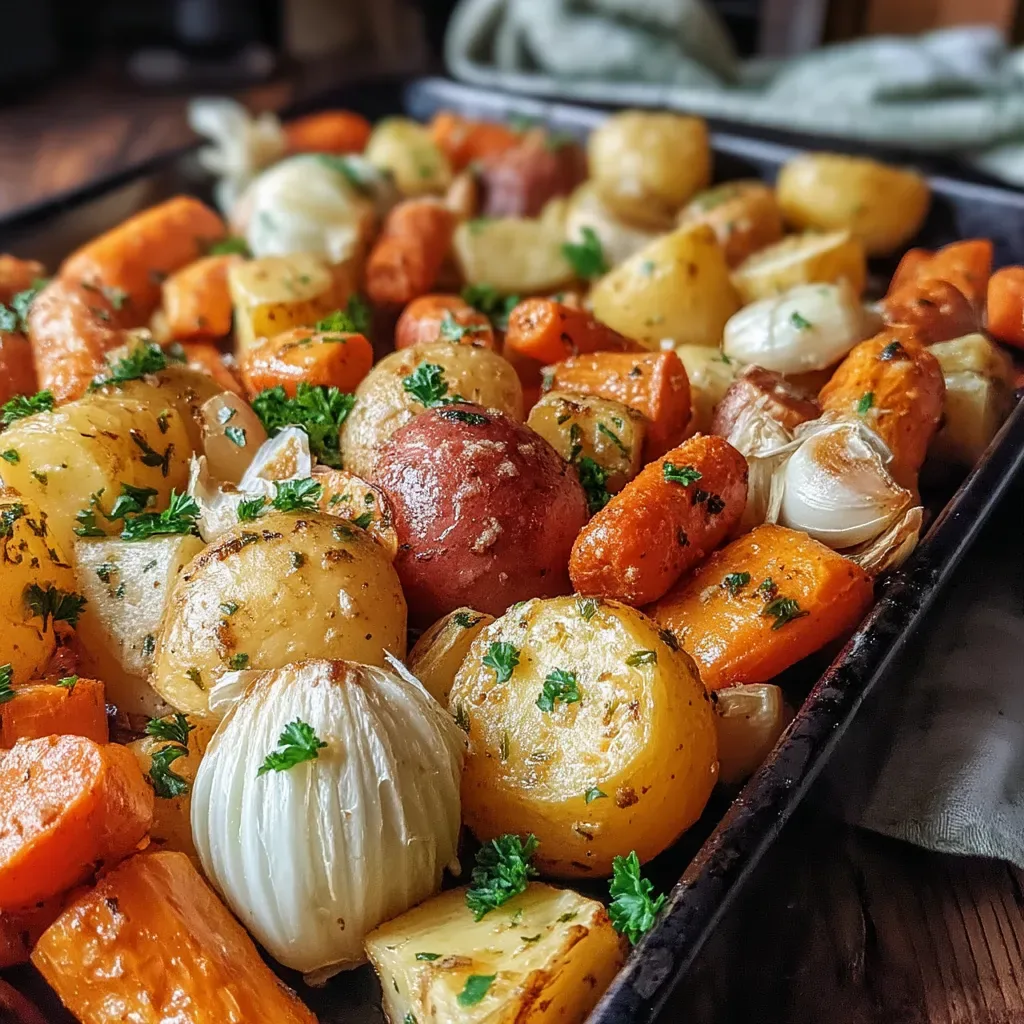Imagine a bowl that looks like a painter’s palette—vibrant carrots, sweet red peppers, emerald broccoli, and golden couscous all mingling together. That’s the magic of the Colorful Roasted Veggie Couscous Bowls, a dish that brings visual excitement and wholesome nutrition to the table in one easy step.
What makes this bowl truly special is the balance of caramelized, oven‑roasted vegetables with fluffy, toasted couscous, all tossed in a bright lemon‑herb dressing. The contrast of textures—crisp edges, tender interiors, and a light, airy grain—creates a satisfying bite every time.
This recipe is perfect for busy professionals, health‑conscious families, or anyone craving a plant‑forward meal that feels indulgent. Serve it for a quick weeknight dinner, a hearty lunchbox, or a colorful side at your next weekend brunch.
The process is straightforward: roast the vegetables, toast the couscous, whisk together a simple dressing, then combine everything in a bowl. A few minutes of prep, a short oven stint, and you have a nutritious, eye‑catching meal ready to enjoy.
Why You'll Love This Recipe
Rainbow of Nutrition: Each vegetable contributes a unique set of vitamins, minerals, and antioxidants, turning the bowl into a nutrient‑dense powerhouse that supports immunity and energy.
One‑Pan Simplicity: The vegetables roast on a single sheet while the couscous cooks on the stovetop, minimizing cleanup and keeping the cooking experience stress‑free.
Customizable Base: Couscous soaks up the lemon‑herb dressing beautifully, but you can swap it for quinoa, farro, or cauliflower rice to match your dietary preferences.
Meal‑Prep Friendly: The bowl stores well, making it ideal for make‑ahead lunches; the flavors actually deepen after a few hours, delivering even better taste.
Ingredients
For this bowl I rely on fresh, seasonal vegetables and a simple yet flavorful dressing that ties everything together. The couscous provides a light, fluffy foundation, while a drizzle of lemon‑herb vinaigrette brightens each bite. Olive oil helps the veggies caramelize, and a handful of toasted pine nuts adds a pleasant crunch. Together these components create a balanced, nutrient‑rich meal that feels both hearty and refreshing.
Main Ingredients
- 1 cup couscous
- 1 ¼ cups vegetable broth (or water)
Roasted Vegetables
- 1 cup broccoli florets
- 1 cup diced red bell pepper
- 1 cup sliced carrots (thin rounds)
- ½ cup cherry tomatoes, halved
- 2 tablespoons olive oil
- ½ teaspoon smoked paprika
Lemon‑Herb Dressing
- ¼ cup extra‑virgin olive oil
- 2 tablespoons fresh lemon juice
- 1 teaspoon Dijon mustard
- 1 garlic clove, minced
- 1 tablespoon chopped fresh parsley
- Salt and freshly ground black pepper, to taste
Seasonings & Garnish
- ¼ cup toasted pine nuts
- Extra fresh parsley for garnish
These ingredients work together to create layers of flavor and texture. The broth‑infused couscous stays light yet flavorful, while the roasted vegetables develop caramelized edges that add depth. The lemon‑herb dressing provides acidity that cuts through the richness of the olive oil and pine nuts, keeping the bowl bright and refreshing. Finally, the garnish adds a pop of color and a pleasant crunch, completing the sensory experience.
Step-by-Step Instructions

Roasting the Vegetables
Preheat your oven to 425°F (220°C). While it heats, toss the broccoli, red bell pepper, carrots, and cherry tomatoes with olive oil, smoked paprika, and a pinch of salt on a large rimmed baking sheet. Spread them in a single layer to ensure even caramelization. Roast for 20‑25 minutes, turning halfway through, until the edges are lightly charred and the vegetables are tender yet still retain a bite.
Cooking the Couscous
While the veggies roast, bring the vegetable broth to a gentle boil in a saucepan. Stir in the couscous, cover, and remove from heat. Let it sit for 5 minutes, then fluff with a fork. This steaming method yields a light, airy grain that absorbs the dressing without becoming mushy.
Preparing the Lemon‑Herb Dressing
In a small bowl, whisk together extra‑virgin olive oil, fresh lemon juice, Dijon mustard, minced garlic, and chopped parsley. Season with salt and pepper to taste. The mustard emulsifies the oil and lemon, creating a smooth vinaigrette that clings to both couscous and vegetables.
Assembling the Bowls
- Layer the Base. Divide the fluffy couscous evenly among four serving bowls. This creates a neutral canvas that soaks up the dressing without becoming soggy.
- Add Roasted Veggies. Distribute the hot, caramelized vegetables over each couscous bed, arranging colors for visual appeal. The residual heat will continue to release flavors as you mix.
- Drizzle Dressing. Spoon the lemon‑herb vinaigrette over each bowl, using about 2‑3 tablespoons per serving. Toss gently to ensure every bite receives a balanced coating.
- Finish with Garnish. Sprinkle toasted pine nuts and a handful of fresh parsley on top. The nuts add crunch, while the parsley reinforces the herbaceous note.
- Serve Warm or Room‑Temperature. These bowls are delicious immediately, but they also hold up well if you let them cool to room temperature for a relaxed lunch.
Tips & Tricks
Perfecting the Recipe
Uniform Cutting. Cut all vegetables to a similar size (about ½‑inch pieces) so they roast evenly and finish at the same time.
Don’t Overcrowd the Pan. Use two baking sheets if needed; overcrowding causes steaming instead of caramelization, dulling flavor.
Rest the Couscous. Allow the couscous to sit covered for a full five minutes; this ensures each grain fully absorbs liquid and stays fluffy.
Flavor Enhancements
Add a pinch of sumac or za’atar to the dressing for an earthy, tangy twist. A drizzle of pomegranate molasses just before serving introduces a subtle sweet‑sour contrast that pairs beautifully with the roasted vegetables.
Common Mistakes to Avoid
Avoid using cold broth for couscous; hot liquid activates the grains instantly. Also, resist the urge to over‑mix the finished bowl—excess agitation can break the delicate couscous and make the texture mushy.
Pro Tips
Toast Pine Nuts First. Lightly toast pine nuts in a dry skillet over medium heat for 2‑3 minutes until golden; this unlocks a nutty aroma that elevates the entire bowl.
Use a Microplane for Lemon Zest. Adding zest to the dressing intensifies citrus flavor without extra acidity, giving the bowl a brighter profile.
Season As You Go. Lightly salt the vegetables before roasting and taste the dressing before adding salt; this layered seasoning prevents over‑salting.
Variations
Ingredient Swaps
Feel free to replace broccoli with cauliflower, or swap carrots for sweet potatoes for extra sweetness. For protein, add grilled halloumi cubes or a handful of chickpeas. If you prefer a different grain, quinoa or pearl barley works beautifully in place of couscous.
Dietary Adjustments
To make the bowl gluten‑free, use certified gluten‑free couscous or substitute with millet. For vegans, replace the honey‑free mustard dressing and ensure the broth is vegetable‑based; add avocado slices for creaminess. Keto dieters can omit the couscous entirely and serve the veggies over cauliflower rice.
Serving Suggestions
Pair the bowl with a simple arugula salad dressed in balsamic vinaigrette, or serve alongside warm pita bread to scoop up extra dressing. A side of lentil soup makes a comforting, complete meal for cooler evenings.
Storage Info
Leftover Storage
Allow the bowl to cool to room temperature, then separate the couscous and roasted vegetables into airtight containers. Store the dressing in a small jar. Refrigerate for up to 4 days. For longer keep, freeze the vegetable mix and couscous in separate freezer‑safe bags for up to 3 months; the dressing stays fresh for 2 months when frozen.
Reheating Instructions
Reheat the vegetables and couscous in a 350°F (175°C) oven for 10‑12 minutes, covered with foil to retain moisture. Alternatively, microwave on medium power for 1‑2 minutes, stirring halfway, and add a splash of broth or extra dressing to revive the texture.
Frequently Asked Questions
This Colorful Roasted Veggie Couscous Bowl brings together wholesome ingredients, bold flavors, and a visually stunning presentation in a single, easy-to‑make dish. By following the step‑by‑step guide, you’ll achieve perfectly caramelized vegetables, fluffy couscous, and a zingy lemon‑herb dressing every time. Feel free to swap veggies, grains, or proteins to suit your palate—cooking is an adventure, after all. Serve, enjoy, and let the rainbow on your plate brighten both your meal and your day!











